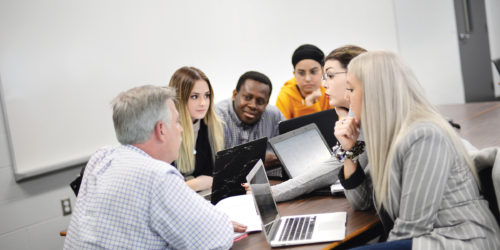
Group Work in Fully Online Learning
Fully online teachers are responsible to support students as they engage in fully online group-based learning. This teaching tip draws from recent literature on conflict in group-based learning to address conflict in fully online group work and suggest tips for minimizing and managing student conflict.
Groups Working Asynchronously Online

Students in asynchronous online courses never meet in the real time in-person or synchronous classroom. Fully online learners are likely to experience similar group work challenges to those they may face during in-person courses: scheduling meetings suiting everyone, relying on others, unequal group contributions, group members lacking skills, and conflict among group members (Soon, 2011).
However, without real-time interaction during structured classes, student may not be ready for self-directed group work that is conducted asynchronously. There are many ways to develop and support fully online groups, paying attention to their needs as groups who may not meet often in real time.
Click each section (+) below for more information.
Why Conflict Happens in Fully Online Group Work
Conflict is a normal—and even productive—part of group work (Tuckman, 1965). However, conflict may be even more likely to arise in fully online group work (Carter et al., 2018) because
- Students may have to adjust to a new way of collaborating, and may be unfamiliar with non in-person group dynamics and how to balance their presence online;
- Students have more autonomy and control over what they respond to or comment on;
- Text-based communication does not include extra-linguistic cues;
- Students may feel disinhibited in expressing negative thoughts or feelings as a result of lack of face-to-face contact;
- Some topics or activities (e.g., self-reflection) may be more likely to lead to contrasting opinions, misunderstandings, and conflict; and
- Distance can promote distrust, yet trust must be built to create conditions that make it easier to collaborate virtually (Smith, 2011).
Researchers investigating virtual group-based learning (see References below) suggest that planning and support from faculty at every stage in the group work process can help mitigate misunderstandings that can lead to conflict, as well as manage conflict more effectively as it arises.
Clarify Expectations and Form Groups Early
To prevent conflict, faculty can clarify expectations early, right when group work is first assigned.
- Creating carefully designed assignments that
- are broken down into checkpoints, with material submitted for formative feedback and /or part marks for coaching the work in progress,
- require students to collect evidence of contribution via drafts, screenshots, emails kept, etc., and
- include individual and/or peer evaluation to reduce the social loafer/free rider effect;
- Describe clearly the purpose, tasks, timelines, and expectations of group assignments;
- Form groups early, giving students a chance to choose a topic or a peer to work with;
- Encourage students to set group expectations early (regarding the type of leadership, response times, online discussion norms, meeting notes), and revisit those expectations continuously throughout the assignment;
- Ask students to choose prescribed roles in their fully online groups based on their relative strengths;
- Explain that Student Success Services offers many types of supports for fully online learners.
Build Rapport and Group Work Knowledge and Skills
Faculty can help students to build and practice group work skills throughout the assignment timeline to minimize conflict as groups work together.
- Conduct an icebreaker about group work: Invite group members to share in a discussion forum post or Padlet times and tools that most benefit their learning;
- Describe in a video recording past experiences with trust, and the risks of miscommunication, in fully online group work;
- Give written and video examples of ways to show respect and goodwill (remaining sensitive to the feelings of others) when group members disagree;
- Provide an asynchronous teambuilding activity that allows students to work together in a low-stakes activity;
- Create collaborative working spaces for fully online groups;
- Provide students with links and support services regarding how to use/where to find technology for learning and collaboration;
- Encourage individuals in groups to consider taking stock of how the group is functioning in addition to what they are producing together;
- Encourage students to meet synchronously online, rather than do all work asynchronously by email or collaborative documents.
Manage Conflict with Early, Progressive Intervention
To manage conflict in fully online groups in a way that shows supportive presence but use active intervention only when needed, faculty can
- Use regular email or form progress updates to monitor escalating conflict;
- Give groups a step-by-step protocol to explore processes and fears so they may attempt to resolve their own problems first:
- Review the group expectations they set together,
- Remind students of their choice of language as well as the importance of asking for clarification to avoid misunderstandings, and
- Encourage students to meet synchronously, not to use email or written messages to discuss conflict;
- Encourage students to listen to honour each other’s their feelings, but to focus on mutually agreeable, solution-based outcomes;
- Monitor group work in collaboration areas and be prepared to step in at any time to mediate serious conflicts;
- Meet with student groups in a synchronous online meeting before and during conflict;
- Remain patient, empathetic, and professional with every student no matter what;
- Make rational conflict-resolution decisions (such as allowing group members to switch groups, changing the assignment, becoming over-involved) as a last resort.
Supporting International Students in Fully Online Group Work
Students from different backgrounds have different expectations and experiences with group work. To support international students from East Asian countries, faculty are reminded that
- Group composition may affect a number of dynamics that go on within student groups, and those dynamics may be culture and/or gender-based;
- Students may be asked to be mindful of biases that can emerge when group members are diverse by culture, gender, and other differences;
- Cultural norms may discourage support seeking in students;
- Frequent and positive feedback will benefit students’ ability to manage emotions;
- Simple behaviours (like procrastination) may be indicating defensiveness or uncertainty about expectations rather than laziness.
References
Carter, I., Damianakis, T., Munro, S., Skinner, H., Matin, S., & Nash Andrews, T. (2018). Exploring online and blended course delivery in social group work. Journal of Teaching in Social Work, 38(5), 486–503. https://doi.org/10.1080/08841233.2018.1523824
Kaenzig, R., Anderson, S., Hyatt, E., & Griffin, L. (2006). Gender differences in students’ perceptions of group learning experiences. Academy of Educational Leadership Journal 10, (1): 119-127. Accessed April 10, 2020.
Smith, R. (2011). Trust in online collaborative groups: a constructivist psychodynamic view. Adult Learning, 22(2), 19–23. https://doi.org/10.1177/104515951102200203
Soon, L. (2011). E-learning and M-learning: Challenges and barriers in distance education group assignment collaboration. International Journal of Mobile and Blended Learning, 3(3), Gale Academic OneFile. Accessed 10 Apr. 2020.
Tuckman, B.W. (1965). Developmental sequence in small groups. Psychological Bulletin, 63 (6): 384–399. doi:10.1037/h0022100.
Xu, J., Du, J., & Fan, X. (2014). Emotion management in online groupwork reported by Chinese students. Educational Technology Research and Development, 62(6), 795–819. https://doi.org/10.1007/s11423-014-9359-0
Zhu, H., Sheng, Y., Zhou, X., & Zhu, Y. (2018). Group role assignment with cooperation and conflict Factors. IEEE Transactions on Systems, Man, and Cybernetics: Systems, 48(6), 851–863. https://doi.org/10.1109/TSMC.2016.2633244







1 Response